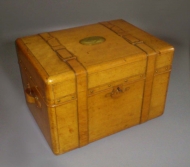Smoker's travel cassette
juin 2016

The spoiled person does not carry his luggage in a knapsack, but longs for forms of luxury that offer overview and practical use. This smokers' travel box proves that such solutions are not completely free of snobbery. With the shape of a twentieth century beauty case, the dedicated nineteenth century smoker was able to impress his friends. That game started with the appearance of the cassette. The outside of a lightly tinted type of wood has as surprise trompe l'oeuil belts with buckles that suggest supple leather, but are carved true to nature. The wooden handles on the sides also seem to be made of leather. After opening with a key, the inside is just as surprising. On a tray at the top we see a mosaic of four pipes surrounded by tubes for cigars and tobacco and two ashtrays. Typically a suitcase for someone who cannot or will not choose between smoking cigars or pipe. The balance seems to be decided here in favor of the cigar. When we take the inner tray out of the suitcase, a so-called cigar cellar, then called cave à cigares, appears with a square wooden tobacco jar at the front. The date is written in pencil in that tobacco jar and it quite unexpectedly mentions the year 1874, at least a quarter of a century earlier than we expect from its appearance. The case was made for the Antwerp architect Otto Geerling, his monogram appears on the lid, as well as on the cigar tubes in the box itself. The craftsmanship with which this object is made is simply breathtaking. For an architect, spun on form and proportion, this case must have been a feast for the eyes. Not only because of the perfect proportions, the ingenious layout, but also because of the great craftsmanship displayed. Nice to know that according to tradition, the chiboucq along the front edge was smoked when Vincent van Gogh visited the Geerling family in 1878. That fact adds the personal note to this exuberant luxury object.
Amsterdam Pipe Museum APM 22.111
Permalink